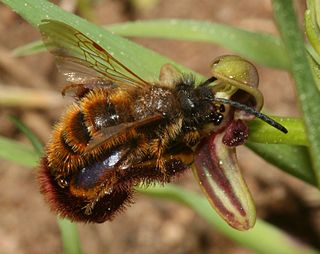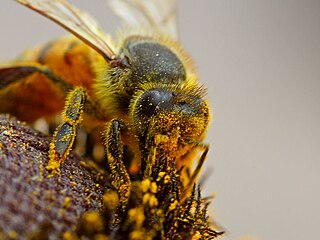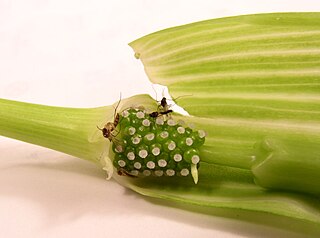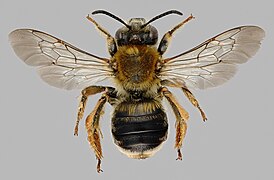
Ophrys apifera, known in Europe as the bee orchid, is a perennial herbaceous plant of the genus Ophrys, in the family of Orchidaceae. It serves as an example of sexually deceptive pollination and floral mimicry, a highly selective and highly evolved plant–pollinator relationship.

A pollinator is an animal that moves pollen from the male anther of a flower to the female stigma of a flower. This helps to bring about fertilization of the ovules in the flower by the male gametes from the pollen grains.

The genus Ophrys is a large group of orchids from the alliance Orchis in the subtribe Orchidinae. They are widespread across much of Europe, North Africa, Caucasus, the Canary Islands, and the Middle East as far east as Turkmenistan.

In evolutionary biology, mimicry is an evolved resemblance between an organism and another object, often an organism of another species. Mimicry may evolve between different species, or between individuals of the same species. In the simplest case, as in Batesian mimicry, a mimic resembles a model, so as to deceive a dupe, all three being of different species. A Batesian mimic, such as a hoverfly, is harmless, while its model, such as a wasp, is harmful, and is avoided by the dupe, such as an insect-eating bird. Birds hunt by sight, so the mimicry in that case is visual, but in other cases mimicry may make use of any of the senses. Most types of mimicry, including Batesian, are deceptive, as the mimics are not harmful, but Müllerian mimicry, where different harmful species resemble each other, is honest, as when species of wasps and of bees all have genuinely aposematic warning coloration. More complex types may be bipolar, involving only two species, such as when the model and the dupe are the same; this occurs for example in aggressive mimicry, where a predator in wolf-in-sheep's-clothing style resembles its prey, allowing it to hunt undetected. Mimicry is not limited to animals; in Pouyannian mimicry, an orchid flower is the mimic, resembling a female bee, its model; the dupe is the male bee of the same species, which tries to copulate with the flower, enabling it to transfer pollen, so the mimicry is again bipolar. In automimicry, another bipolar system, model and mimic are the same, as when blue lycaenid butterflies have 'tails' or eyespots on their wings that mimic their own heads, misdirecting predator dupes to strike harmlessly. Many other types of mimicry exist.

Pseudocopulation is a behavior similar to copulation that serves a reproductive function for one or both participants but does not involve actual sexual union between the individuals. It is most generally applied to a pollinator attempting to copulate with a flower adapted to mimic a potential female mate. The resemblance may be visual, but the key stimuli are often chemical and tactile. The form of mimicry in plants that deceives an insect into pseudocopulation is called Pouyannian mimicry after the French lawyer and amateur botanist Maurice-Alexandre Pouyanne.

Entomophily or insect pollination is a form of pollination whereby pollen of plants, especially but not only of flowering plants, is distributed by insects. Flowers pollinated by insects typically advertise themselves with bright colours, sometimes with conspicuous patterns leading to rewards of pollen and nectar; they may also have an attractive scent which in some cases mimics insect pheromones. Insect pollinators such as bees have adaptations for their role, such as lapping or sucking mouthparts to take in nectar, and in some species also pollen baskets on their hind legs. This required the coevolution of insects and flowering plants in the development of pollination behaviour by the insects and pollination mechanisms by the flowers, benefiting both groups. Both the size and the density of a population are known to affect pollination and subsequent reproductive performance.

The tribe Euglossini, in the subfamily Apinae, commonly known as orchid bees or euglossine bees, are the only group of corbiculate bees whose non-parasitic members do not all possess eusocial behavior.

Ophrys insectifera, the fly orchid, is a species of orchid and the type species of the genus Ophrys. It is remarkable as an example of the use of sexually deceptive pollination and floral mimicry, as well as a highly selective and highly evolved plant–pollinator relationship.

Drakaea is a genus of 10 species in the plant family Orchidaceae commonly known as hammer orchids. All ten species occur only in the south-west of Western Australia. Hammer orchids are characterised by an insectoid labellum that is attached to a narrow, hinged stem, which holds it aloft. The stem can hinge only backwards, where the broadly winged column carries the pollen and stigma. Each species of hammer orchid is pollinated by a specific species of thynnid wasp. Thynnid wasps are unusual in that the female is flightless and mating occurs when the male carries a female away to a source of food. The labellum of the orchid resembles a female thynnid wasp in shape, colour and scent. Insect pollination involving sexual attraction is common in orchids but the interaction between the male thynnid wasp and the hammer orchid is unique in that it involves the insect trying to fly away with a part of the flower.
Sexual mimicry occurs when one sex mimics the opposite sex in its behavior, appearance, or chemical signalling.

Chemical mimicry is a type of biological mimicry involving the use of chemicals to dupe an operator.

In evolutionary biology, mimicry in plants is where a plant evolves to resemble another organism physically or chemically. Mimicry in plants has been studied far less than mimicry in animals. It may provide protection against herbivory, or may deceptively encourage mutualists, like pollinators, to provide a service without offering a reward in return.

Pollination traps or trap-flowers are plant flower structures that aid the trapping of insects, mainly flies, so as to enhance their effectiveness in pollination. The structures of pollination traps can include deep tubular corollas with downward pointing hairs, slippery surfaces, adhesive liquid, attractants, flower closing and other mechanisms.

Ophrys speculum, the mirror orchid, is a species of Ophrys distributed throughout the Mediterranean that is pollinated exclusively by a single species of scoliid wasp.

Advertising in biology means the use of displays by organisms such as animals and plants to signal their presence for some evolutionary reason.

Argogorytes mystaceus is a species of solitary wasp in the family Bembicidae.
Floral biology is an area of ecological research that studies the evolutionary factors that have moulded the structures, behaviours and physiological aspects involved in the flowering of plants. The field is broad and interdisciplinary and involves research requiring expertise from multiple disciplines that can include botany, ethology, biochemistry, and entomology. A slightly narrower area of research within floral biology is sometimes called pollination biology or anthecology.

The monocots are one of the two major groups of flowering plants, the other being the dicots. In order to reproduce they utilize various strategies such as employing forms of asexual reproduction, restricting which individuals they are sexually compatible with, or influencing how they are pollinated. Nearly all reproductive strategies that evolved in the dicots have independently evolved in monocots as well. Despite these similarities and their close relatedness, monocots and dicots have distinct traits in their reproductive biologies.

Floral Isolation is a form of reproductive isolation found in angiosperms. Reproductive isolation is the process of species evolving mechanisms to prevent reproduction with other species. In plants, this is accomplished through the manipulation of the pollinator’s behavior or through morphological characteristics of flowers that favor intraspecific pollen transfer. Preventing interbreeding prevents hybridization and gene flow between the species (introgression), and consequently protects genetic integrity of the species. Reproductive isolation occurs in many organisms, and floral isolation is one form present in plants. Floral isolation occurs prior to pollination, and is divided into two types of isolation: morphological isolation and ethological isolation. Floral isolation was championed by Verne Grant in the 1900s as an important mechanism of reproductive isolation in plants.

The pollination of orchids represents a complex aspect of the biology of this plant family, characterized by intricate flower structures and diverse ecological interactions with pollinator. Notably, the topic has garnered significant scientific interest over time, including the attention of Charles Darwin, who is recognized for his contributions to the theory of evolution by natural selection. In 1862, Darwin published his observations on the essential role of insects in orchid pollination in his work The Fertilization of Orchids. He noted that the various strategies employed by orchids to attract their pollinators are complex.























